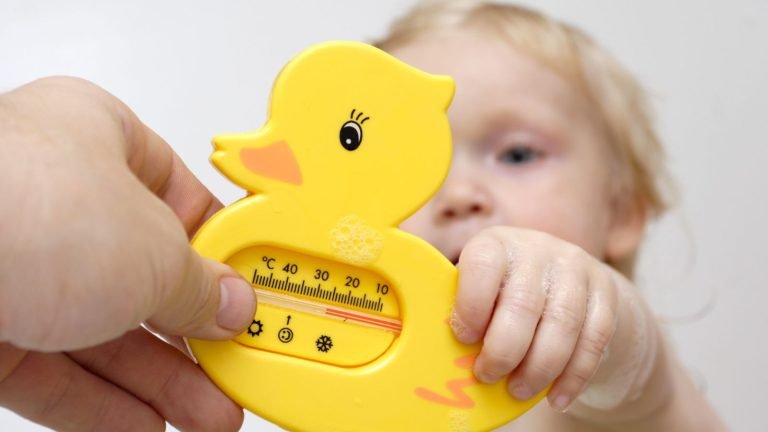Wake Windows Age Guide: Crafting Your Baby’s Absolute Ideal Sleep Routine in 2025

Have you ever wondered how long your little one should stay awake between naps or before bedtime?
Following the recommended Wake Windows Age Guide can help ensure your child gets the rest they need for healthy development and a happy disposition.
From newborns to school-aged children, we break down the ideal wake windows for each stage, providing valuable insights and practical tips.
Wake windows can help you to:
Improve your baby’s sleep: Following age-appropriate wake windows can help your baby sleep better at night and throughout the day.
Reduce fussy behavior: Overtired babies can be fussy and difficult to soothe. Following wake windows can help to prevent overtiredness and fussiness.
Establish a healthy sleep-wake cycle: A consistent sleep-wake cycle is important for your baby’s health and development.
So, let’s dive in and discover the secrets to promoting a well-rested and contented child.
Key Takeaways – Wake Windows Age Guide
- Wake windows vary depending on the age group, with newborns having the shortest wake windows and preschoolers having the longest.
- Following age-appropriate wake windows helps establish healthy sleep patterns and prevents babies from becoming overtired.
- Paying attention to sleep cues and signs of fatigue helps determine the appropriate time for napping or wakefulness.
- Creating a sleep-friendly environment, such as a calming routine and removing distractions, is important for promoting better sleep for children of all ages.
Baby Wake Windows By Age: Find The Right Wake Window

Get ready for sweet dreams! Understanding wake windows by age is like having a secret weapon for your baby’s sleep. These special time frames guide you in creating the perfect sleep routine for your baby and toddler.
Navigating your baby’s sleep patterns is essential to ensuring a well-rested and happy little one. Recognizing signs of an overtired baby and responding promptly is crucial for a peaceful sleep routine.
Understanding how long your baby can comfortably stay awake and when they need that one crucial nap is key to preventing fatigue and promoting quality sleep.
By tuning into cues and being mindful of your baby’s tired signals, you can establish a bedtime routine that helps your baby to sleep soundly, contributing to their overall well-being.
Here is a table of recommended wake windows by age:
| Age | Wake Window |
|---|---|
| 0-4 weeks | 45-60 minutes |
| 4-12 weeks | 60-90 minutes |
| 3-4 months | 75-120 minutes |
| 4-6 months | 90-150 minutes |
| 6-9 months | 1.5-2 hours |
| 9-12 months | 2-3 hours |
| 12-18 months | 2-3 hours |
| 18-24 months | 2-3 hours |
How To Use Wake Windows?

Mastering wake windows is a game-changer for ensuring your baby or toddler gets to sleep. Begin by understanding your baby’s unique needs and setting an appropriate wake window tailored to their age.
Here are some tips for using wake windows:
Pay attention to your baby’s sleep cues: Put your baby down for a nap when you see signs that they are tired.
Create a consistent nap schedule: A consistent schedule will help your baby to regulate their sleep-wake cycle.
Avoid overtiredness: Overtired babies can be difficult to put to sleep. Try to put your baby down for a nap before they become overtired.
Adjust as needed: Every baby is unique, and their wake windows may vary slightly from the recommended ranges. Observe your baby’s sleep patterns and adjust the wake windows as needed.
Twin Manage: If you have twins, tailor their wake window schedule precisely using the guidance of Wake Window Twins Management.
Customize their sleep schedule based on age, ensuring they rest properly. Stick to age-appropriate wake windows throughout the day, even if your baby takes short naps.
This approach guarantees a well-rested and content baby, contributing to better sleep quality and overall well-being.
Newborn Wake Windows: Wake Windows Matter
As a parent of a newborn, you should be aware of the recommended wake windows for your baby’s age. Understanding your baby’s sleep schedule and wake windows is important for their well-being.
Newborns have very short wake windows, usually lasting 45 minutes to an hour. This means that they can only stay awake for a short period before needing to go back to sleep. Keeping your baby awake for too long can result in overtiredness and difficulties with falling asleep.
It’s important to create a calm and soothing environment for your newborn during their wake windows, helping them to wind down before their next nap.
Wake Windows for Infants: Baby Sleep Cues
To ensure your infant gets the right amount of sleep, it’s important to understand the appropriate wake windows for their age.
Wake windows refer to the length of time your baby can comfortably stay awake before needing to sleep again. Age-appropriate wake windows are important in establishing healthy sleep patterns for your little one.
For infants, it’s recommended to follow short wake windows. Newborns aged 0-3 months can only handle around 45 minutes to 1 hour of wakefulness before showing sleep cues like yawning or rubbing their eyes.
As your baby grows, their wake windows will gradually increase. Around 3-6 months, the recommended wake window is 1-2 hours; for 6-9 months, it extends to 2-3 hours. By 9-12 months, infants can handle 3-4 hours of wakefulness before needing a nap.
Wake Windows for 3-6 Month Olds: Age-appropriate Wake Window

For 3-6-month-olds, you should aim for a wake window of 1-2 hours before they need to nap. This is because babies are still developing their sleep patterns at this age and need shorter periods of wakefulness before getting tired.
By using wake windows, you can help prevent your baby from becoming overtired and make it easier for them to fall asleep. Pay attention to your baby’s cues and establish a consistent schedule.
When you notice signs of sleepiness, such as rubbing their eyes or yawning, it’s a good indicator that it’s time to put your baby down for a nap.
Wake Windows for 6-9-Month-Olds

At 6-9 months old, your baby’s wake window should gradually increase to accommodate their growing sleep needs. During this stage, your baby becomes more active and curious about the world around them.
They’re starting to develop a more predictable sleep pattern, with longer stretches of wakefulness and longer naps.
Pay attention to your baby’s cues and timing to ensure they get the right sleep. Watch for signs that your baby is awake and alert, such as increased movement, babbling, or exploring their surroundings. As the day progresses, your baby will show tired signs, such as rubbing their eyes or becoming fussy.
When your baby wakes up from a nap, give them enough time to rest and recharge before their next sleep period. Remember, each baby is unique, so observing and adjusting to your baby’s sleep needs is important.
Wake Windows for 9-12-Month-Olds

During this stage, your 9-12 month-old’s wake window expands to meet their increasing sleep needs. Putting your baby down for naps and bedtime at the right time is important to ensure they get the required rest.
Get your baby ready for sleep by creating a calming routine that signals it’s time for rest. Your baby may take two or three naps daily, lasting around 1-2 hours. However, every baby is different, so pay attention to their cues and adjust accordingly.
Remember that a well-rested baby is happier and healthier, so prioritize their sleep and establish consistent wake windows to promote good sleep habits.
Wake Windows for Toddlers (1-2 Years)

As your baby transitions into toddlerhood, it becomes important to adapt their wake windows to accommodate their changing sleep patterns and energy levels.
Toddlers aged 1-2 years typically require around 11-14 hours of sleep in 24 hours, including naps.
Most toddlers still take two naps a day at this stage, but some may transition to one longer afternoon nap.
Wake windows for toddlers in this age range can vary between 3-5 hours, depending on their needs.
It is important to observe your toddler for signs of tiredness, such as rubbing their eyes, yawning, or becoming fussy.
Wake Windows for Preschoolers (3-5 Years)

Preschoolers aged 3-5 years typically have wake windows ranging from 5-7 hours. Your child’s sleep needs are still significant during this stage, but they may transition to a single nap instead of two shorter ones. Establishing a consistent sleep schedule is important to promote healthy sleep habits.
Preschoolers thrive on routine, so establish a regular wake-up time and bedtime. Aim for a consistent nap time in the afternoon, usually around midday. This will help regulate their body clock and ensure they get enough rest.
Remember that every child is different, and while some preschoolers may still require two naps, others may be ready to transition to a single nap. Look for signs of sleepiness, such as yawning, rubbing eyes, or crankiness, and adjust their schedule accordingly.
Create a soothing sleep environment with a comfortable bed and a consistent bedtime routine. Implement a wake window night weaning strategy to help your child sleep through the night.
Wake Windows for School-Aged Children (6-12 Years)

For school-aged children (6-12 years), it’s important to adjust their wake windows to accommodate their growing sleep needs and promote optimal rest.
Children require around 9-12 hours of sleep per night at this stage to support their physical and cognitive development.
To ensure they get enough sleep, it’s recommended to establish a consistent bedtime routine and stick to a regular sleep schedule.
School-aged children may still need naps, but these should be limited to 30-45 minutes daily to avoid interfering with nighttime sleep.
Additionally, it’s important to create a sleep-friendly environment by keeping the bedroom dark, quiet, and at a comfortable temperature.
Creating a Wake Window Schedule for Your Baby ensures a more manageable and structured approach to bedtime and naps, enhancing overall sleep quality.
Summary
Understanding the appropriate wake windows for each age group is important for the well-being and development of children.
By following these guidelines, parents and caregivers can ensure their little ones get the right rest and stimulation throughout the day.
Remember, each age group has different needs, and being mindful of these wake windows can contribute to a happier and healthier child. So, remember these recommendations and create a schedule that suits your child’s age and needs.
Frequently Asked Questions
How Do Wake Windows Impact a Child’s Sleep Schedule?
Wake windows impact a child’s sleep schedule by determining how long they can stay awake before sleeping. Understanding wake windows helps you create a routine that promotes healthy sleep habits for your child.
Are There Any Negative Effects of Not Following Wake Windows for a Specific Age Group?
Not following wake windows for a specific age group can negatively affect your child’s sleep. It can lead to overtiredness, difficulty falling asleep, and disrupted sleep patterns. Stick to the recommended wake windows for optimal sleep.
Can Wake Windows Be Adjusted Based on a Child’s Individual Sleep Needs?
Yes, wake windows can be adjusted based on your child’s sleep needs. Observing their behavior and cues is important to determine the optimal time for them to wake up and go to sleep.
Are Wake Windows the Same for All Children Within a Specific Age Group?
Wake windows may vary among children within the same age group. Each child has unique sleep needs, so paying attention to their cues and adjusting wake windows for optimal rest is important.
How Do Wake Windows Change as a Child Grows and Develops?
As your child grows and develops, their wake windows will naturally change. It’s important to understand how these changes occur and adjust their sleep schedule to ensure they get the rest they need.





